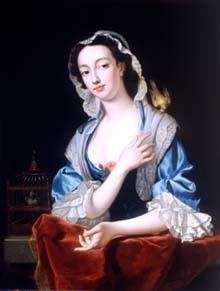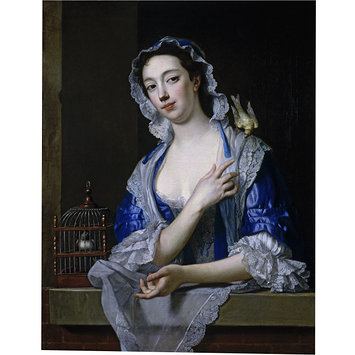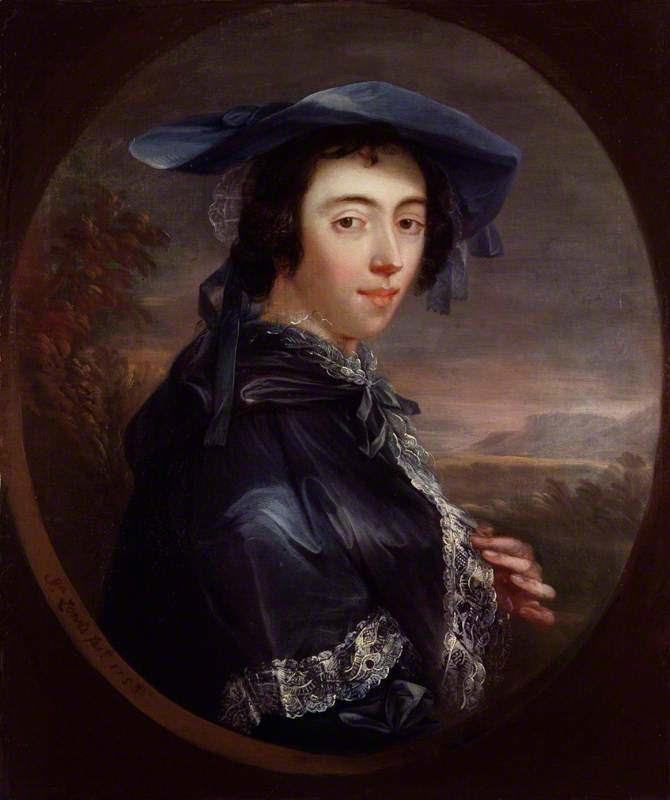Name Peg Woffington | Role Actress | |
 | ||
Died March 26, 1760, Westminster, United Kingdom | ||
Margaret "Peg" Woffington (18 October 1720 – 28 March 1760) was a well-known Irish actress in Georgian London.
Contents

Early life

Woffington was born of humble origins in Dublin. Her father is thought to have been a bricklayer, and after his death, the family became impoverished. Her mother was obliged to take in washing while Peg sold watercress door to door. It is said that she was walking through a marketplace as a pre-teen and happened upon Madame Violante, a famous tightrope walker.

Signora Violante was so immediately enthralled by Peg’s beautiful face that she accompanied Peg home and asked her mother permission to take Peg in as his apprentice.
Around 1730, Madame Violante featured Peg as Polly Peachum in a production of John Gay’s The Beggar’s Opera. This served as a springboard for Woffington’s fame in Dublin, and she continued dancing and acting in the area – playing Dorinda in an adaptation of The Tempest as the Theatre Royal, Dublin in 1735 and joining the Smock Alley Theatre to perform with well known actor, David Garrick.
Acting career
She danced and acted at various Dublin theaters until her success as Sir Harry Wildair in The Constant Couple led to her being given her London debut at Covent Garden; she became well known as an actress thereafter.
Woffington enjoyed success in the role of Sylvia in The Recruiting Officer. She performed at Drury Lane for several years and later returned to Dublin, appearing in a variety of plays. Her most well-received performances were in comic roles, such as elegant women of fashion like Lady Betty Modish and Lady Townley, and breeches roles. She was impeded in the performance of tragedy by a harsh tone in her voice that she strove to eliminate.
She lived openly with David Garrick, the foremost actor of the day, and her other love affairs (including liaisons with Edward Bligh, 2nd Earl of Darnley and MP Charles Hanbury Williams) were numerous and notorious. She became friend and mentor to the socialite/actress sisters, Elizabeth and Maria Gunning, and also shared the stage with the likes of Charles Macklin, Kitty Clive, and the tragedienne Susannah Maria Arne (then known as Cibber, following her marriage to Theophilus Cibber).
Though she was popular with society figures, having entertained such illustrious names as Samuel Johnson and Henry Fielding, Peg Woffington was not always favored by her competition. She tended to create rivalries with similar-type actresses at Drury Lane and Covent Garden. She even managed to offend “tragediennes for whom Peg’s comic powers posed no threat” with her “ queenly ways”. Her fiercest rivalry was with “equally peppery” actress Kitty Clive. According to Garrick biographer Thomas Davies, “No two women in high life ever hated each other more unreservedly than these two great dames of the stage.” When she returned to Covent Garden, rivalries with these women and with the manager, Mr. Rich, eventually sent her back to Dublin, where she was unrivaled and celebrated at the Smock Alley Theatre.
John Rich, manager of Covent Garden in London, decided to start a Beefsteak Club in 1749, also known as the Sublime Society of Steaks or “the Club.” Some of its members included Garrick and William Hogarth, as well as many other London celebrities. Not only was Peg Woffington the first female member of a (previously) all male dining club, in 1750 she became president of the club by election. She also educated and supported her sister Mary (usually known as Polly), and cared for and pensioned her mother.
For whatever reason, Woffington left Garrick in about 1744 and moved to Teddington, into a house called Teddington Place. In 1754 she became the beneficiary of the will of the Irish impresario Owen Swiny. In 1756, she performed the part of Lady Randolph in Douglas, a part which found a later exponent in Sarah Siddons.
On 3 May 1757, she was playing the part of Rosalind in As You Like It when she collapsed on stage. She rallied, but would never act again, lingering with a wasting illness until 1760. She built and endowed by will some almshouses at Teddington, and was buried in St. Mary's Church, the parish church.
Portraits
A beauty, Woffington appeared in portraits and paintings by several artists of the day, including Jacobus Lovelace in 1744, Peter van Bleeck in 1747, and John Lewis in 1753. She was eulogised in a poetical sketch by the dramatist Henry Jones.
She has been portrayed as a character in the stage plays A Laughing Matter by April De Angelis. and Mr Foote's Other Leg by Ian Kelly.
Popular culture
In 1852 Charles Reade and Tom Taylor wrote a play Masks and Faces which featured Woffington as a central character. Following the play's success, Reade wrote a novel Peg Woffington the following year.
Woffington featured in several films, particularly in the silent era. These portrayals were largely based on the works of Reade and Taylor and include Peg Woffington (1910), Peg Woffington (1912) and Masks and Faces (1917). In 1935 Anna Neagle played Woffington in the comedy Peg of Old Drury with Cedric Hardwicke playing David Garrick. Her character appeared in the 2015 play Mr Foote's Other Leg as a friend and colleague of Samuel Foote.
